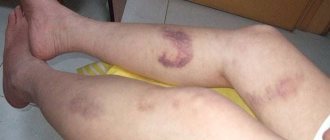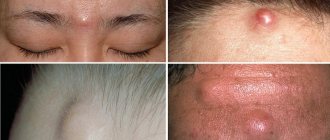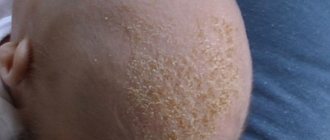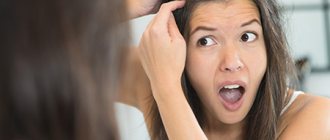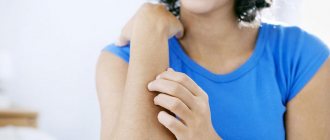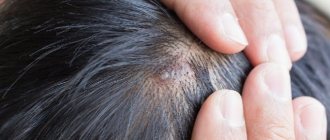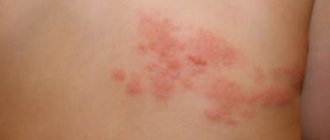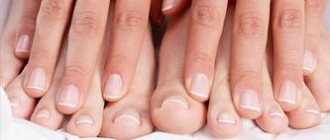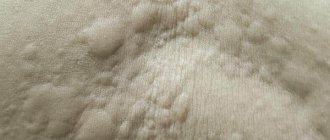Noticeable dullness of hair, brittleness, itching or burning sensation, redness and the appearance of pigmentation - one or more of these signs may indicate problems with the scalp.
In some cases, the condition of patients is complicated by hair loss, the appearance of bald patches, and the damaged area becomes more and more disturbing.
In this article we will talk about one of the special cases - the appearance of scabs on the scalp.
Reasons for appearance
A crust on the head of an adult can appear for various reasons:
- allergic manifestations;
- avitaminosis;
- excess weight;
- incorrectly selected cosmetics for hair care. Especially if it contains a large amount of alkali;
- excessive secretion of subcutaneous sebum;
- daily hair washing. Natural subcutaneous fat does not have time to be fully released, there is no protective lubricant and dandruff forms in the form of a crust;
- infrequent washing can also cause the formation of a crust of dandruff;
- metabolic disease;
- hormonal changes (puberty, pregnancy, lactation, menopause);
- an unbalanced diet when losing weight or excessive consumption of unhealthy foods (fatty, spicy, salty, fried, etc.);
- diseases of the gastrointestinal tract;
- excessive drinking and smoking;
- improper daily routine (lack of sleep is especially harmful);
- systematic drying of the skin that occurs when using thermal devices;
- stress.
All of the above factors are favorable for the main reason for the appearance of a crust on the scalp in adults - increased activity of a pathogenic fungus. It is present on the head of every person and is part of the microflora of the skin. In a healthy body, the fungus does not manifest itself in any way, but under the influence of the listed circumstances, it begins its active activity. This is how the manifestation of seborrheic dermatitis (wet or dry) begins. That is why almost all hair dandruff remedies are aimed at combating this fungus.
Skin diseases on the head in children
The most common causes of weeping wounds on a child’s head are:
- Burns;
- Trophic ulcers;
- Dermatitis.
These diseases are characterized by a wet surface and fluid separation. They are characterized by the presence of two stages - regeneration and scarring. Some of the wounds are characterized by a lack of fluid.
The condition of the wound is directly affected by the child’s immune system. When a baby's head is injured, bacteria enters the wound, which turns it into a weeping wound.
Difficulties in treating weeping wounds in children arise due to the fact that children do not understand the full danger of the disease and therefore scratch them. Most often, treatment is carried out using certain medications.
In this case, it is strictly forbidden to self-medicate, as this can lead to complications.
In order to ensure the outflow of fluid from the wound, water-soluble ointments are used - Levosin or Levomekol. Doctors do not recommend using Vishnevsky ointment to treat a pathological condition in children. Also, children should not take antibiotics and regular ointments. During the treatment of small patients, complete sterility must be maintained.
Treatment of weeping wounds in children should be carried out under the strict supervision of a physician. That is why parents are advised to seek help from specialists at the first signs of illness.
What you need to know
Seborrheic crusts on the head are an inflammatory disease. The cause of its occurrence is a fungus that promotes natural exfoliation of the upper layers of the skin.
It is this that provokes the appearance of dandruff, and later a crust appears in the scalp. The fungus is most active on oily skin, but those with dry and normal hair can also become victims of seborrheic dermatitis.
At the first symptoms of the disease, the skin itches. After this, small reddish spots appear on the head, which peel off. A crust forms on the scalp from dead epidermal cells.
It can be easily separated and adhere firmly to the skin. In the latter case, its separation is associated with pain, and can also cause the formation of wounds and even ulcers. If no measures are taken, the itching intensifies, and the person notices that the head is covered with clearly visible dandruff.
At first, seborrheic dermatitis is not particularly dangerous. There is physical and aesthetic discomfort. It also creates a certain obstacle to hair growth in the area of crust formation. But if the problem is not dealt with, a bacterial infection is added to the disease. This means that in addition to a crust on the head, other diseases may appear. When the condition is severely neglected, hair begins to fall out, forming bald spots.
Signs of seborrhea most often appear in the autumn-winter period, when a person’s immunity is weakened.
Important! Dandruff is a fungal disease, and it can be transmitted through personal hygiene products: comb, towels, etc.
A crust of dandruff appearing on the scalp in children can be considered normal, but in adults it is a signal of alarming symptoms. If a flaky and itchy layer forms on the scalp, this is a reason to consult a doctor (trichologist or dermatologist) for a thorough examination. After all, it is not always the case that the scalp is covered with a white crust – this is a manifestation of fungal activity. White flaky formations can be a signal of more serious problems: psoriasis, scabies (the activity of the scabies mite), favus (the appearance of the achorion fungus, another name for the disease is scab, favus lichen), ringworm, etc.
The earlier the visit to a specialist, the easier the diagnosis is made and the faster the treatment.
Diagnostics
The cause of the pathology is determined by a dermatologist. If necessary, he refers the patient to other specialists. If a hormonal imbalance is suspected, women should consult an endocrinologist and gynecologist. In case of stress, the patient needs to visit a neurologist. An important step is differential diagnosis, which helps to separate one disease from another. It is carried out on the basis of the following studies:
- Skin scraping. The taken material is examined in a laboratory to identify the causative agent of the disease.
- Wood's lamp examination. This diagnostic method identifies various types of lichen.
- General blood analysis. Can confirm the presence of an inflammatory process in the body.
- Dermatoscopy. This is an examination of the lesions using a dermatoscope - a magnifying device that helps to examine the affected area in detail.
- Allergy tests. They help determine whether the crusts are caused by allergic reactions to hair care products.
The formation of crusts can be associated with disorders of various vital organs and systems, so it is important to undergo a more complete examination. If a particular disease is suspected, the doctor may prescribe a number of additional diagnostic procedures:
- gastroscopy;
- determination of blood glucose levels;
- rhino- or pharyngoscopy;
- liver tests to assess liver health;
- Ultrasound of the pelvic and abdominal organs;
- hormonal and immunological blood tests.
Tips and tricks to resolve the problem
To get rid of crust on the scalp, it is important:
- find out from the doctor why the flaky areas appeared;
- strengthen the immune system. This will help: a course of vitamins, exercise, sufficient consumption of vegetables and fruits, giving up alcohol and tobacco;
- eliminate stressful conditions;
- drink about 2 liters of pure water per day;
- stick to a healthy diet (avoiding fatty, spicy, etc.). Normal activity of the gastrointestinal tract will reduce the formation of affected areas;
- choose shampoos and other caring cosmetics without aggressive ingredients. It is better to take plant-based products;
- get rid of the allergen, if we are talking about allergic manifestations of dandruff;
- use medicinal cosmetics prescribed by the doctor.
Folk remedies also give good results as a complete treatment, or complementing drug treatment.
After successful therapy, dandruff in the form of a crust on the epidermis may return, especially if you do not adhere to a healthy lifestyle.
Drug treatment
If you ask your doctor how to get rid of crusts, he may recommend ointment (applied with a cotton swab), shampoo (frequent washing) or a combination of these products. In particularly advanced cases, antibiotic therapy and other alternative methods are prescribed.
Effective drugs
Sulsena
It is a favorite among other means of combating the problem. The main active component is selenium disulfide. Normalizes the condition of the skin, reduces fungal activity, normalizes the functioning of the sebaceous glands, has an exfoliating effect and restorative properties.
It is used both as a shampoo for scalp crusts and as a paste. Often both remedies are used in combination. The cost of shampoo or peeling shampoo is about 300 rubles, the paste is about 120 rubles.
Naftaderm
The main component of the ointment is Naftalan refined oil. It is used for any diseases that result in the formation of a dry crust on the head of an adult. Use twice a day for a month. The cost of the drug is within 500 rubles.
Attention! It is recommended to combine therapy with emollient creams and oils to avoid excessive dryness of the skin.
Keto plus
The active ingredients of the shampoo are zinc pyrithione and ketoconazole. Effective in the treatment of dandruff caused by Malassezia furfur (yeast microorganisms). The course of treatment depends on the type of disease and is carried out according to the scheme. The cost of Keto Plus ranges from 720 rubles.
Salicylic ointment
It is based on salicylic acid, which has antiseptic and regenerating properties. Softens dry crusts and relieves inflammation. Treatment lasts from 6 to 20 days. Depending on the type of disease and the general condition of the skin, it is used both in pure form and diluted with Vaseline. The most affordable product, the price of which ranges from 25 rubles.
Dry seborrhea
Dry seborrhea occurs for the same reasons as the oily variety, but this disease has its own individual characteristics:
- The main symptom is severe drying of the skin, which leads to flaking of the scalp and the appearance of a large amount of dandruff; its color may vary. Against the background of dandruff formation, severe itching gradually begins to be felt and a general deterioration in the condition of the hair is observed.
- To treat dry seborrhea, complex therapy is used, which will consist of the use of antifungal drugs and shampoos with a moisturizing effect to restore water balance. At the discretion of the specialist, physiotherapeutic procedures may be prescribed, including cryotherapy, mesotherapy or cryomassage. In the most advanced and complex situations, hormonal-type pharmacological medications and medications with high levels of zinc are prescribed.
- Preventive measures are exactly the same as for oily seborrhea.
https://youtube.com/watch?v=8kvatWhZ82U
Folk remedies
If the disease is not advanced, you can get rid of it with the help of alternative medicine, or combine such methods with medical prescriptions.
Henna
It is one of the most popular remedies in the fight against dandruff.
How to use: pour 60 g of powder with boiling water (you need enough water to get the consistency of sour cream), then cool. You can also dilute the ointment with rosemary and/or tea tree essential oils. Apply to affected areas for half an hour and rinse with warm water.
To prevent your curls from becoming colored, it is better to use colorless henna. The recipe can be supplemented with a decoction of St. John's wort, apple cider vinegar, orange juice, burdock oil, and blue clay.
Unripe (green) walnut
Option #1. 100 g of crushed nut shells are poured with vodka (0.5 l) and infused for 2 weeks. Afterwards the infusion is filtered. Used by massaging into the skin every other day for 20 days.
Option #2. 300 g of crushed leaves, peel and shell are poured into a liter of water and brought to a boil in a water bath. Then the broth is removed from the heat and infused for 2 hours.
How to use: As a rinse after washing your hair. Afterwards, wrap your head in a towel and leave for at least 10 minutes. Repeat the procedure 3-5 times. The effect is noticeable from the first use.
Important. Walnut can dye strands a dark color, so it is better not to use it on light-colored hair.
Kefir
Apply with rubbing movements to the entire surface of the scalp and leave for half an hour. Wash off with rinse aid (1 tbsp dry mustard diluted in 1 liter of warm water). Do it daily for a week. Then repeat the procedure for preventive purposes once a month.
Burdock root
The young root of the plant is crushed (in a meat grinder or grater) and mixed with vegetable oil (1:3). Next, the mixture must be infused for an hour in a glass jar. Then strain and rub into the skin 2-3 times a week. Warm up before use. There should be a total of 10 such rubbings. The next course is repeated after 20 days.
Burr oil
When heated, apply to the scalp. Then the head must be covered with polyethylene, wrapped in a towel and left for 2 hours. Rinse off.
nettle leaves
A tablespoon of crushed leaves is poured into a glass of boiling water. The resulting infusion must be covered, wrapped and kept for 1.5 hours. Strain. Apply to skin after washing, cover head with a bag and leave for 40 minutes. There is no need to wash your curls after the procedure. Use the product twice a week.
Chamomile flowers
Boil table 2. spoons of flowers with 1 liter of water. Cool and strain. Dilute with plain water in a ratio of 1:10 and rinse your hair after washing three times a week. Do 15 procedures, then pause for 3 weeks and repeat the course again.
Chamomile gives light strands a golden hue.
Sage
Infuse for 1 table. spoon of dry sage herb with 1 glass of boiling water for 24 hours. Rub in every other day for a month. This remedy is good for dry seborrhea. For oily dandruff, replace the water in the recipe with a glass of vodka.
Tea tree oil
Powerful antiseptic. For treatment, it is better to add it to shampoo. In its pure form it can cause burns.
Oak bark
For medicinal purposes, you need to prepare an infusion of a tablespoon of bark, poured with 400 ml of boiling water. All this is infused in a water bath for 5 minutes, then filtered. Rub the infusion into the scalp 3-4 times a day, adding a tablespoon of flower honey to the liquid.
Alternative Methods
Used in especially severe cases.
Photochemotherapy
Comprehensive approach:
- taking special drugs that create fluorescence, psoralens orally;
- exposure to a prescribed dose of UVA.
Depending on the severity of the disease, different treatment regimens are used. They all come down to two phases: cleansing (2-3 sessions per week until symptoms disappear) and maintenance (once a week for a month, can be extended at intervals of once a month).
Important! Photochemotherapy is contraindicated in children. Women should use contraception to prevent pregnancy during treatment.
Laser therapy (physiotherapy)
Prescribed as an additional means of combating dandruff. The treatment is carried out with a laser beam that focuses photons (low intensity light). Photons improve blood circulation and help activate enzyme metabolism, resulting in the restoration of damaged tissue.
Plasmolifting (plasmotherapy)
The procedure involves subcutaneous injections obtained as a result of processing the patient’s blood in a special centrifuge (obtaining plasma rich in platelets and active components). It not only relieves dandruff and itching, but also helps with other hair problems (loss, weakened condition, etc.).
Plasmolifting has a number of contraindications, which include:
- allergy to anticoagulants;
- chronic or acute diseases;
- menstruation period;
- presence of tumors, hematomas;
- autoimmune diseases;
- pregnancy and lactation.
Vitamin therapy
Recommended for vitamin deficiency resulting in dandruff. The complex of vitamin preparations must include vitamins and microelements: A, F, E, B (1–6, 8, 9, 12), H, C, selenium.
How soon can you get rid of
It all depends on the severity of the disease and how carefully the doctor’s recommendations are followed. The general condition of the body also plays an important role.
On average, the effect of treatment is noticeable after 4 or more weeks. By using pharmaceutical and folk remedies, you can achieve stable remission in the fight against the disease. And following a proper lifestyle will prevent dandruff from appearing in the future.
Like any other disease, dandruff is easier to prevent than to treat. But even if a problem appears, you can achieve positive results quickly. The main thing is to see a doctor in time and follow all his instructions.
In addition, the effectiveness of the fight against seborrhea can be enhanced by using traditional medicine recipes and other alternative methods. But all these steps need to be discussed with your doctor. This will help avoid side effects and create positive dynamics of recovery.
Why does the red spot on the skin peel off?
When a child has an allergic reaction, red spots appear in certain areas of the body, which over time begin to peel and itch. Then small blisters may appear in their place. After some time after contact with the allergen, skin irritation goes away.
This causes great discomfort to the baby: the flaky spots constantly itch, the child sleeps poorly and cries. In addition, in addition to the appearance of red spots, other allergy symptoms may appear:
- runny nose;
- cough;
- vomit;
- diarrhea;
- temperature increase;
- eyes become red and watery;
- the appearance of swelling on the body.
If a red, scaly spot appears on a child’s body, it is best not to self-treat, but to seek help and advice from a medical specialist.
